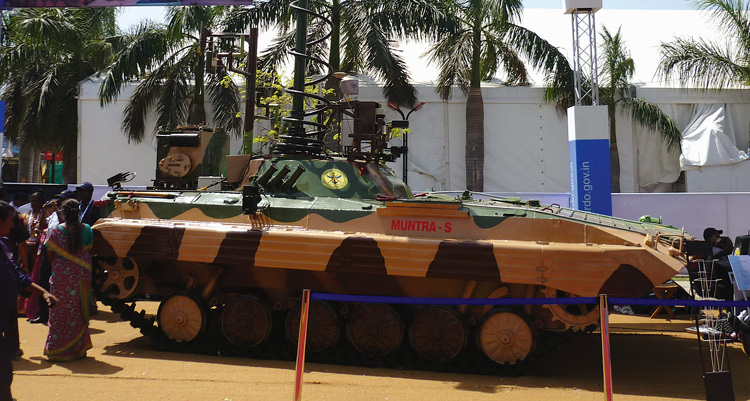- Prime Minister Narendra Modi inaugurates Aero India 2023 in Bengaluru; Releases Commemorative Stamp
- Defence Secretary meets delegations from Saudi Arabia, USA and Oman on the sidelines of Aero India 2023
- Foreign Ministers of 32 countries to attend Aero India 2023
- Embraer showcases the C-390 Millennium at Aero India 2023
The robot army

Defexpo is perhaps the only event in the country where India's unmanned ground vehicle programmes become visible. After a great showing at Defexpo 2010, the Indian robots are back. In the time between the last show and this, the Daksh remotely-operated bomb disposal and ordnance handling robot has begun inductions into the Army. With six delivered and 14 more to join the Army shortly, the robotic vehicle will be used in border areas and sensitive theatres.
With that success under its belt the Defence Research and Development Organisation (DRDO) is now getting the Army to evaluate a new fighting robot, currently simply called the Gun Mounted Robot (GMR). The DRDO has pitched the GMR as a potential asset in hostage situations counter-insurgency missions. Developed with good cross-country endurance and mobility, the DRDO GMR sports a 7.62mm light machine gun (with beltfed ammunition) and 30mm grenade launcher. Both weapons use high-intensity lasers to aim, with simultaneous azimuth and elevation control. The GMR's integrated pano- vision camera provides a 180-degree view. The rugged master control station has a touch screen and joystick based controls.
One of the big debuts at Defexpo 2012 is DRDO's MUNTRA (mission unmanned tracked) unmanned tracked ground vehicle. There are two variants of the BMP-2 based vehicles, one configured for surveillance missions and the other a base vehicle from where the active MUNTRA is operated. The MUNTRA has a surveillance suite consisting of an indigenously developed Battlefield Surveillance Radar (BFSR), a daylight/low light camera, a thermal imaging video camera and a laser range finder. Using the BFSR, the base vehicle operator can detect and track a wide variety of ground targets from a range of 50 metres to 12 km in all environments. Targets can also be visually detected and monitored in day/night using optical systems. Details of detected targets are displayed on the operator's console unit in the base vehicle, superimposed on an IMGRS GIS map. Communication devices and surveillance systems are mounted on remotely controlled telescopic masts.
DRDO laboratories are also developing water-jet robots and search vehicles that assist in handling potentially dangerous or suspicious items in trains or houses.
In ten years, half of all combat functions of the Indian armed forces “should either be supported or taken over to a large extent by unmanned robotic weapon systems” according to India's highly ambitious Unmanned Warfare Doctrine, which envisages at least 16 indigenous military robot development programmes, most of them unknown. Programmes in development include a high-altitude border patrol robot, an unmanned assault boat, even an autonomous battlefield search and rescue vehicle. Programmes that the government has been fairly open about include the autonomous underwater vehicle (AUV), the Predator-like unmanned bomber based on the Rustom long endurance drone, the mini surveillance drone Netra, and the Nishant unmanned aerial vehicle.





